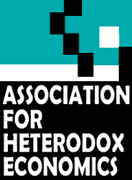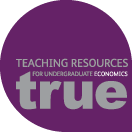References
Barone, C. (1991). ‘Contending Perspectives: Curricular Reform in Economics’, Journal of Economic Education, 22: 15–26. DOI 10.1080/00220485.1991.10844694
Becker, W. (2004). ‘Economics for a Higher Education’, International Review of Economics Education, 3 (1): 52–62. DOI 10.1016/S1477-3880(15)30145-6
Bowles, S. and Gintis, H. (1985). ‘The Production Process in a Competitive Economy: Walrasian, neo-Hobbesian and Marxian Models’, American Economic Review, 75 (1): 16–36. JSTOR 1812702
Brokken, R. and Bywater, A. (1982). ‘Application of Isoquant Analysis to Forage: Grain Ratios in Cattle Feeding’, Journal of Animal Science, 54 (3): 463–472.
Dayal, V. (2013). ‘Towards pluralism in a public economics course in India’, International Journal of Pluralism and Economics Education, 4 (4): 400-406. DOI 10.1504/IJPEE.2013.060179
Dollars and Sense (2016). Real World Micro: A Microeconomics Reader, Cambridge, MA: Economic Affairs Bureau. 23rd edition.
Dorman, P. (2014a). Microeconomics: a fresh start, New York: Springer.
Dorman, P. (2014b). Macroeconomics: a fresh start, New York: Springer.
Galbraith, J. K. (1958). The Affluent Society, London: Hamish Hamilton.
Galbraith, J. K. (1967). The New Industrial State, Boston: Houghton Mifflin.
Goodwin, N. and Harris, J. (2001). ‘Better Principles: New Approaches to Teaching Introductory Economics’, GDAE Institute Working Paper 01-05.
Harvey, J. (2014). ‘Teaching Keynes’ business cycle: an extension of Paul Davidson’s capital market model’, Journal of Post Keynesian Economics, 36 (4): 589-606. DOI 10.2753/PKE0160-3477360401
Harvey, J. (2015). Contending perspectives in economics: a guide to contemporary schools of thought, Cheltenham: Edward Elgar.
Heilbroner, R. (2000). The Worldly Philosophers: The Lives, Times and Ideas of the Great Economic Thinkers, London: Penguin.
Heilbroner, R. (1997). Teachings from the Worldly Philosophy, New York: Norton.
Himmelweit, S., Simonetti, R. and Trigg, A. (2001). Microeconomics: Neoclassical and Institutionalist Perspectives on Economic Behaviour, Thomson.
Kemp, T. and Wunder, T. (2007). ‘Simulating inequality and social order in the classroom: A macroeconomic game’ Review of Social Economy, 65(4): 425-443. DOI 10.1080/00346760600863189
Keynes, J. M. (1936). The General Theory of Employment, Interest and Money, London, Macmillan.
Lavoie, M. (2014). Post-Keynesian Economics: New Foundations, Cheltenham: Edward Elgar.
Lee, F. S., (2010). A heterodox teaching of neoclassical microeconomic theory. International Journal of Pluralism and Economics Education, 1(3), pp.203-235.
Mallin, C. A. (Ed.). (2009). Corporate social responsibility: a case study approach. Edward Elgar Publishing.
Mavroudeas, S. (2013). ‘Teaching political economy and Marxism at an introductory level: a view from Greece’, International Journal of Pluralism and Economics Education, 4(3): 282-295. DOI 10.1504/IJPEE.2013.058262
McDonough, T. (2012). ‘Integrating heterodox economics into the orthodox introductory course’, International Journal of Pluralism and Economics Education, 3 (4): 437-449. DOI 10.1504/IJPEE.2012.052696
McCloskey, D. (1994). Knowledge and Persuasion in Economics, Cambridge: Cambridge University Press.
Minsky, H. P. (1992). ‘The financial instability hypothesis’, Working Paper 74, The Levy Economics Institute. DOI 10.2139/ssrn.161024
Mishkin, F. (2013). The Economics of Money, Banking and Financial Markets, New York: Pearson.
Mullainathan, S. and Shleifer, A. (2005). ‘Persuasion in Finance’, NBER Working Papers, 11838, National Bureau of Economic Research. DOI 10.3386/w11838
Ozanne, A. (2016). Power and neoclassical economics: a return to political economy in the teaching of economics, London: Palgrave.
Parrique, T. (2015). ‘Planting the seed of change: a student-led introduction course to economics’. International Journal of Pluralism and Economics Education, 6 (3): 219-236. DOI 10.1504/IJPEE.2015.074353
Rubin, R. (2002). [https://faculty.biu.ac.il/~levyda/greatideas2006.pdf "Diminishing Marginal Productivity in Class."] Resources for Economics Teaching, Vol. 2004: Chapel Hill.
Salemi, M. (2005). ‘Teaching Economic Literacy: Why, What, and How?’, International Review of Economics Education, 4 (2): 46–57. DOI 10.1016/S1477-3880(15)30132-8
Smith, Adam (1976 [1776]). An Inquiry into the Nature and Causes of the Wealth of Nations, Oxford: Clarendon.
Stretton, H. (1999). Economics: A New Introduction, London: Pluto.
Tomer, J. (2001). ‘Economic Man vs. Heterodox Men: the Concepts of Human Nature in Schools of Economic Thought’, Journal of Socio-Economics, 30: 281–293. DOI 10.1016/S1053-5357(01)00100-7
Veblen, T. (1967 [1899]). The Theory of the Leisure Class: An Economic Study of Institutions, New York: Funk & Wagnalls.
Warnecke, T. (2009). ‘Teaching globalisation from a feminist pluralist perspective’. International Journal of Pluralism and Economics Education, 1 (1-2):93-107. DOI 10.1504/IJPEE.2009.028968



